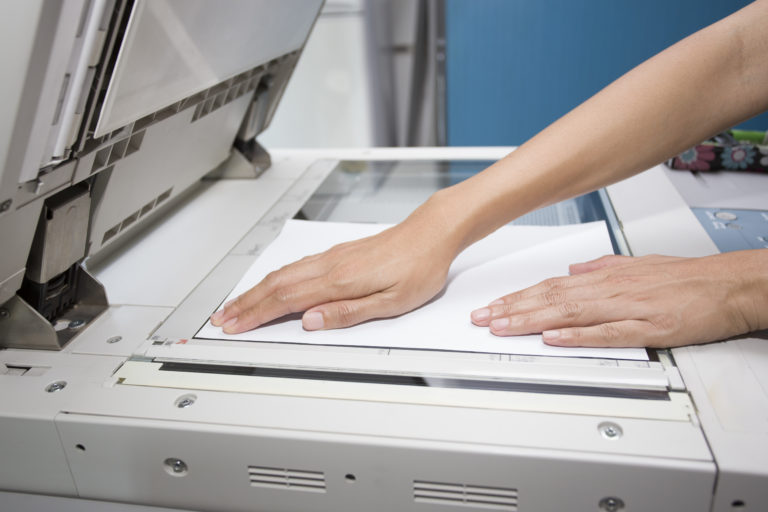Click here to download this blog as a PDF.
Many businesses today are on the road to becoming paperless. With benefits such as increased efficiency, more space, and cost-savings, it’s a no-brainer why so many companies are making the switch. However, many businesses forget that there are some decisions you must make to figure out what path you want to take to get your business entirely paperless. One of the first and most important decisions is how you plan to scan your documents. There are two leading solutions for document scanning: outsourcing or doing it yourself (DIY). As a document management company, we know the ins and outs of document scanning. We have seen clients DIY, outsource, and even do a combination of both. When it comes to document scanning, there isn’t a “better” way to do it. You need to understand your business needs and see how they align with either option. Don’t worry; we can help!
To make the right decision for your business, you want to understand your options. Outsourcing and DIY document scanning both have their benefits and drawbacks, but as we have said before, it is all about your business needs. Throughout this blog, we will be going through critical points you need to consider when choosing which way of scanning is ideal for your business.
Document Volume
You first want to think about how many documents your business would need to digitize to have an entirely paperless business. Let’s say your business only has a small number of documents that require scanning, and these documents don’t need complex indexing. A simple flatbed, sheet-fed, or portable scanner would be a great option in this scenario. It is cost-effective, user-friendly, and can be done easily in house, so it is a great DIY option. However, you do need to consider that this is best suited for a small number of documents. If you have a large volume of documents and try this DIY way, you may run into the issue of taking up too much manual work for the employee responsible for the task. These small volume scanners usually have a throughput of 1-10 pages per minute, so time is also something you want to think through when choosing between DIY and outsourcing.
There are many options of scanners that you can purchase, depending on your volume. However, if you do have a large volume of documents and records that need to be scanned and indexed, outsourcing may be your best option in the long run. High-end scanners can be difficult to manage on your own and usually require trained operators. If your business plans to scan a high volume of documents regularly, the investment of a high-end scanner could be the way to go. However, outsourcing will be your best option if you look to take all your documents and records in bulk and get them scanned. This allows you to take many documents and get them scanned a lot faster than a simple scanner. Although this is a more expensive option, by outsourcing, you will know that the people scanning your documents are trained and will get the job done in a shorter amount of time, depending on volume. You also want to consider that you will usually need to think about how you will transport your physical documents to the scanning location. There is also a hybrid option where you hire a scanning service to come to you and do it on-site (scanning directly into your system) to save you time uploading yourself. You may also have a large number of documents that you need to scan initially and some later. This is where you can utilize both options and outsource for the initial bulk and DIY the rest.
Document Size
Now that we talked through how many documents you would need to scan, let’s talk about the actual size of these documents. Are they all regular legal size? Or do you have much larger documents? Most entry-level scanners can handle 8.5″ x 11″ paper and can usually go down to the size of a business card. If your business doesn’t have any large documents or images that need scanning, doing it yourself is a perfectly viable option. However, if you are dealing with larger documents, you’ll probably need to outsource. When it comes to scanning large documents, you need specialized hardware and a large format scanner. You can buy this equipment, but many businesses just send it off due to not wanting to invest in such large and complex equipment.
Indexing
Depending on the content within your documents and how easily you want to retrieve them later on, indexing may or may not be a high priority for your business. Indexing is the process of classifying information that describes a document and allows you to search and find said document once it is digitized easily. If you are scanning a large number of documents at once, indexing is necessary, or else you will have no way to find these documents quickly and can add on manual time. There are multiple methods used for indexing documents depending on how you want to search your documents and how long you want the process to take.
Indexing is more complex than most people think. However, you can purchase your own advanced capture software if you plan to go the DIY route. Depending on how you want to index your documents, doing it yourself could be more cost effective for your business. If you have documents that are used daily and need-finding quickly and efficiently, outsourcing might be the best option for indexing your documents. Some scanning services usually do as little indexing as possible (maybe only a unique ID for a contact/company). Later use that ID to do a lookup into an existing DataBase to pull in additional info.
Cost
When people think of DIY, they usually see it as a more budget-friendly option; that is true for document scanning. Usually, if you go down a DIY route and don’t have many documents to scan, the overall price is lower than if you choose to outsource. This isn’t 100% true for every circumstance, but the DIY route is more budget-friendly. For example, if you decide to outsource for document scanning, they usually charge per page, then you get them as images and/or PDFs. After that, you have to upload them to your document management system (DMS), and indexing would cost even more per page due to more and longer labor. Whereas with the DIY option, you are mainly just paying for equipment, although you do have to consider the upkeep of equipment and software and any manual labor needed.
Security
Depending on your business’s industry, you may have some documents that need high security due to law obligations. These could be client information, contracts, etc. Suppose your business has these types of documents. In that case, outsourcing to a document scanning company could help you ensure that your documents stay safe and could possibly have relevant certifications to guarantee this. Of course, there is always room for human error regarding security when going the DIY route. However, if you plan to scan documents that do not have highly sensitive information, DIY could be a better and more cost-efficient option.
Which is Better?
As we said before, there isn’t a “better” option. It all depends on the needs of your business when it comes to document scanning. You may realize that you don’t need to outsource, and you can just DIY to save money. You may utilize both outsourcing and DIY as well. Overall you want to get your documents fully digitized for your business to be fully paperless. Once you are paperless and have your documents digitized, you can start looking at a document management system that can help you streamline these documents. Here at Optix, we can help you upload, index, and more once your documents are scanned. If you are still having trouble figuring out how to pick the best solution for your company, contact us today, and we’d be happy to discuss the right option for you.
Click here to download this blog as a PDF.


 Mindwrap, Inc
Mindwrap, Inc